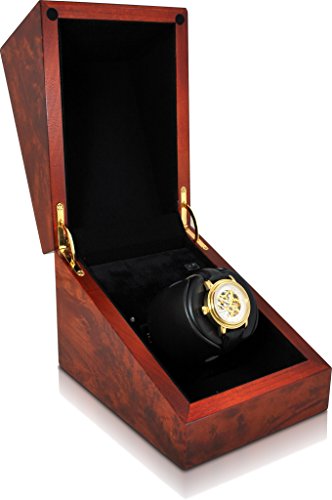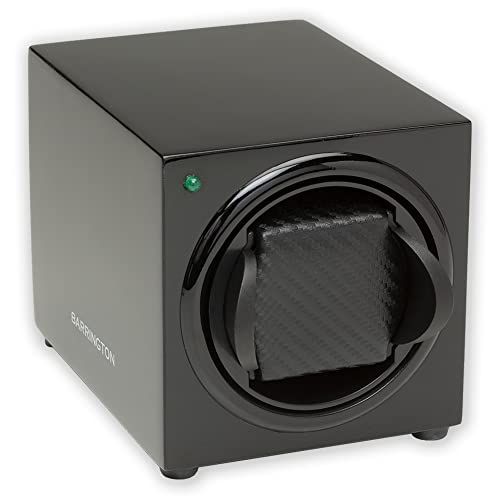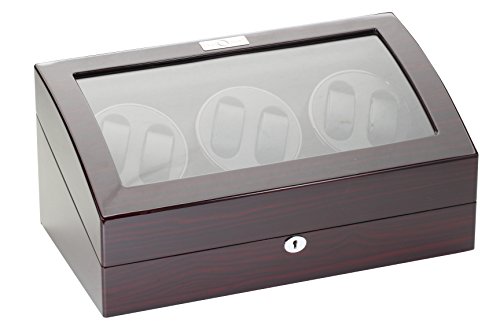As watch enthusiasts, we understand the importance of keeping our timepieces in optimal condition. And that’s where a watch winder comes in. Whether you’re a novice or a seasoned collector, this step-by-step guide is designed to help you navigate the world of watch winders with confidence and ease. From understanding their purpose to learning how to use them safely, we’ve got you covered. So sit back, relax, and let’s dive into the world of watch winders together.
Top Picks for Watch Winder Safes
What is a Watch Winder?
A watch winder is a device designed to keep automatic watches wound and running smoothly when they are not being worn. It is especially useful for those who own multiple automatic watches and find it impractical to wear each one regularly.
How does a Watch Winder work?
A watch winder consists of a motor that rotates the watch in a controlled manner, mimicking the natural motion of a wrist. This rotation ensures that the watch’s mainspring is continually wound, keeping the watch running accurately and preventing it from losing time or stopping.
Benefits of using a Watch Winder
Using a watch winder offers several benefits for automatic watch owners. Here are some key advantages:
Convenience
- Eliminates the need for constantly resetting time and date when changing watches.
- Ensures that your watch is always ready to wear, no matter which one you choose.
Preservation
- Prevents the degradation of lubricants inside the watch due to prolonged inactivity.
- Reduces the wear and tear caused by manual winding or resetting.
Prevents Loss of Accuracy
- Keeps the watch movement running smoothly, ensuring accurate timekeeping.
- Prevents the movement from losing its timekeeping abilities due to extended periods of inactivity.
Personalization
- Some watch winders offer customizable settings, such as rotation direction and speed, to cater to the specific needs of your watch.
- Provides the opportunity to display and showcase your watch collection in an elegant and organized manner.
Comparing Watch Winders
If you’re in the market for a watch winder, it is essential to consider a few factors before making your purchase. Here is a quick comparison to help you choose the right one for your needs:
| Feature | Single Winder | Multi Winder | Premium Winder |
|---|---|---|---|
| Capacity | 1 watch | Multiple watches | Multiple watches |
| Customizable | Limited options | More options | Extensive options |
| Direction control | Some models | Many models | Many models |
| Rotation Speed | Some models | Many models | Many models |
| Power source | Battery or AC | Battery or AC | AC |
Choosing the Right Watch Winder
Choosing the right watch winder for your automatic timepiece is an essential decision to prevent it from losing its accuracy and ensuring its long-term functionality. With a wide array of options available in the market, it can be overwhelming to find the perfect fit for your needs. In this comprehensive guide, we will walk you through the important factors to consider when selecting a watch winder.
Types of Watch Winders
1. Single Watch Winders
Single watch winders are designed to wind one watch at a time. They are great for collectors who own a limited number of automatic watches or for those who prefer to wind their favorite timepiece individually.
Key features and benefits:
- Ideal for enthusiasts with a small watch collection.
- Provides dedicated winding for a single watch.
- Compact and space-efficient.
2. Multiple Watch Winders
Multiple watch winders are perfect for individuals with a larger collection of automatic watches. They can accommodate several timepieces simultaneously, providing convenience and efficiency.
Key features and benefits:
- Designed for watch collectors with multiple watches.
- Capable of winding several watches concurrently.
- Space-saving solution.
3. Modular Watch Winders
Modular watch winders allow users to customize the configuration according to their collection size and preferences. They provide the flexibility to add or remove watch winders as needed.
Key features and benefits:
- Adaptable design to cater to watch collections of any size.
- Offers the ability to expand or downsize the winder setup as required.
- Enables the organization and arrangement of watch winders according to personal preferences.
Sizing Considerations
1. Watch Compatibility
When choosing a watch winder, ensure that it is compatible with the size and weight of your automatic watch. Check the box or user manual of your timepiece for any specific requirements recommended by the manufacturer.
2. Space Availability
Consider the available space where you intend to place the watch winder. Measure the dimensions and ensure that the winder will fit comfortably in the allocated area. It’s also worth considering if you might expand your collection in the future and plan accordingly.
Essential Features
1. Rotation Settings
The rotation settings of a watch winder determine the turning direction and the number of rotations per day (TPD) necessary to keep your watch in optimal condition. Look for winders that offer various rotation settings to cater to different watch models.
2. Programmed Delay and Sleep Modes
Some watch winders feature programmed delay and sleep modes to mimic the natural movement of the wrist. These modes provide rest intervals for the timepiece, preventing overwinding and unnecessary wear and tear.
3. Power Supply Options
Consider the power supply options available for the watch winder. While most models can be connected to a standard electrical outlet, some also offer battery-powered functionality. Battery backup can be useful during power outages or when traveling.
4. Aesthetic Appeal
Choose a watch winder that complements your personal style and the decor of the space it will occupy. Many manufacturers offer a range of materials, finishes, and designs to satisfy various aesthetic preferences.
Price Range
Watch winders are available in a wide variety of price ranges. Consider your budget and the value you place on your automatic watches. It’s important to strike a balance between quality and affordability to ensure you’re getting a reliable winder that meets your needs.
In conclusion, selecting the right watch winder requires careful consideration of the type, size, features, and price range. By understanding these key factors, you can make an informed decision that ensures your timepieces are well-maintained, accurate, and ready to be worn at any time. Happy watch winding!
Setting Up the Watch Winder
Congratulations on your new watch winder! Properly setting up your watch winder is essential to ensure that it functions correctly and keeps your automatic watches wound and ready to wear. In this blog section, we will guide you through the step-by-step process of setting up your watch winder, covering important aspects such as adjusting rotation direction and speed to match your watch’s specifications.
Step 1: Unboxing and Preparing the Watch Winder
Before you begin setting up your watch winder, carefully unbox it and inspect for any damage during shipping. Ensure that all the components are included, such as the watch pillows and power adapter.
- Carefully remove the watch winder and its components from the packaging.
- Check for any visible damage or defects. If you notice any, contact the manufacturer or retailer for assistance.
- Gather all the necessary components, including the watch pillows and power adapter.
- Place the watch winder on a level surface, away from direct sunlight and extreme temperature changes.
Step 2: Configuring Rotation Direction
Next, you’ll need to configure the rotation direction of your watch winder. Different watches have different winding requirements, so it’s important to set the rotation direction that suits your specific timepiece.
- Refer to your watch’s manual or contact the manufacturer to determine the optimal rotation direction. Most automatic watches will require either clockwise (CW), counterclockwise (CCW), or bidirectional rotation.
- Locate the rotation direction switch on your watch winder. It is usually located at the back or side of the winder.
- Set the switch to the appropriate rotation direction according to your watch’s specifications. Most watch winders offer multiple rotation options, so choose the one recommended for your watch.
Step 3: Adjusting Rotation Speed
After you’ve set the rotation direction, it’s time to adjust the rotation speed to match your watch’s requirements. This step ensures that your watch is wound optimally without causing unnecessary stress to its movement.
- Again, consult your watch’s manual or contact the manufacturer to determine the recommended rotation speed (turns per day, or TPD) for your particular watch.
- Locate the TPD control knob on your watch winder. It is usually found on the back or the inside of the winder.
- Slowly turn the TPD control knob to adjust the rotation speed. Some winders may offer preset speeds, while others allow you to set a custom TPD value.
- Set the rotation speed to match your watch’s specific rotation requirements.
Step 4: Placing Your Watches in the Watch Winder
Now that you’ve configured the rotation direction and speed, it’s time to place your watches in the watch winder. Proper placement ensures that your watches receive maximum winding efficiency.
- Select the appropriate watch pillows provided with your watch winder. The pillows should be compatible with the size of your watches.
- Gently place each watch on a separate watch pillow. Ensure that the watches fit properly and are securely held in place.
- Close the watch winder’s door or cover, securing the watches inside.
- Make sure that the watches are evenly spaced and do not touch each other or the sides of the watch winder. This prevents unnecessary friction and potential damage.
Congratulations! You’ve successfully set up your watch winder, tailored to meet the specific needs of your automatic watches. Now you can sit back and enjoy the convenience of having your watches automatically wound, keeping them in optimal condition.
Key Points to Remember:
- Carefully unbox and inspect for any damage before setting up the watch winder.
- Configure the rotation direction to match your watch’s specifications.
- Adjust the rotation speed (TPD) to meet your watch’s winding requirements.
- Place your watches securely on the watch pillows, ensuring they are evenly spaced.
- Avoid placing the watch winder in direct sunlight and extreme temperature changes.
Setting up your watch winder correctly ensures that your automatic watches receive the care they deserve, allowing you to enjoy the convenience and longevity of your timepieces. Take the time to configure your watch winder accurately, and your watches will always be ready to wear whenever you need them.
Maintaining and Troubleshooting
Congratulations on your purchase of a watch winder! To ensure its longevity and optimal performance, it is crucial to properly maintain and troubleshoot your device. In this blog section, we will provide you with valuable tips and guidance on how to keep your watch winder in top condition.
Regular Cleaning
Proper cleaning is essential for a smooth and efficient operation of your watch winder. Here are some steps to follow when cleaning your device:
- Unplug the watch winder: Before cleaning, always unplug the watch winder from the power source to ensure safety.
- Remove the watches: Take out any watches placed inside the watch winder.
- Use a soft cloth: Wipe the exterior of the watch winder using a clean, soft, lint-free cloth to remove any dust or dirt.
- Avoid liquid cleaners: Refrain from using any liquid cleaners or solvents, as they may damage the finish of your watch winder.
- Gently clean the interior: Using a lint-free cloth or a soft-bristled brush, gently clean the interior compartments to remove any debris or dust. Be careful not to apply excessive force or scratches may occur.
- Reassemble the watch winder: Once the cleaning is done, reassemble the watch winder and plug it back in.
Noise Reduction
Is your watch winder making more noise than you’d like? Follow these steps to minimize the noise level:
- Check the surface: Place your watch winder on a stable and even surface. Uneven surfaces may cause unnecessary vibrations and noise.
- Tighten screws and connections: Check if any screws or connections are loose. If so, tighten them gently to minimize any rattling noises.
- Lubricate moving parts: Apply a small amount of high-quality lubricant to the rotating parts of your watch winder to reduce friction and noise.
- Inspect watch cushion condition: Examine the condition of the watch cushion inside the watch winder. If it seems worn or damaged, it might be a good idea to replace it. A damaged cushion can cause unnecessary noise due to improper fit.
Power Supply Issues
Encountering power supply problems can be frustrating, but fear not! Here are some common troubleshooting steps for power-related issues:
- Check the power outlet: Ensure that the power outlet you’re using is functioning correctly. Plug another device into the outlet to confirm if it’s the source of the problem.
- Inspect the power cord: Look for any visible signs of damage or wear on the power cord. If you notice any, it may be necessary to replace it.
- Verify cable connections: Make sure all cable connections are secure and not loose. Check both ends of the power cord to ensure a proper connection to the watch winder and the power outlet.
- Consult the user manual: If the above steps do not resolve the issue, consult the user manual that accompanied your watch winder for specific troubleshooting recommendations.
Comparison Table: Key Features for Maintenance and Troubleshooting
| Maintenance Tips | Troubleshooting Steps |
|---|---|
| Regularly clean the exterior and interior of the watch winder. | Check the surface and tighten loose screws to reduce noise. |
| Use a soft cloth and avoid liquid cleaners. | Lubricate moving parts for noise reduction. |
| Gently clean the interior compartments to remove debris. | Inspect and replace worn or damaged watch cushions that cause noise. |
| Check the power outlet and power cord for issues. | |
| Verify secure cable connections. | |
| Refer to the user manual for further troubleshooting guidance. |
Bringing it all together: The Final Steps
In conclusion, this step-by-step guide highlights the crucial role of a watch winder in maintaining the performance of automatic watches. By considering the watch’s specifications and personal preferences, choosing the right watch winder is essential. By taking these steps, you can ensure that your timepiece remains in optimal condition for years to come.














![Versa [Newly Upgraded] Automatic Double Watch Winder in Black - New Direct Drive Motor, Independently Controlled Settings, 12 Different Settings, Adjustable Watch Pillows - No Magnets](https://m.media-amazon.com/images/I/41aWD3Jmv2L.jpg)

